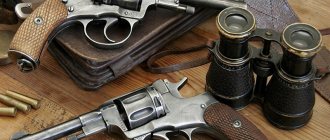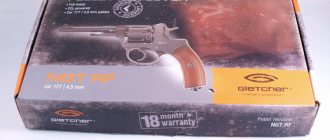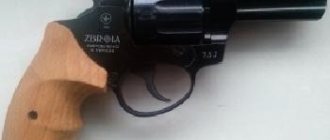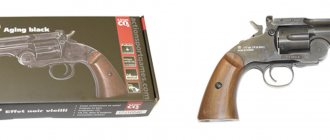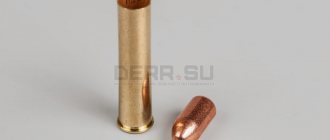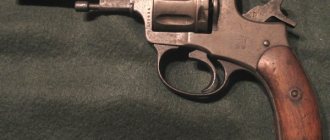Review of cold pistols Revolver Nagant
In our online store you can get answers to these questions, get advice, and purchase the following types of cooled Nagan Revolver at the best price:
Nagan RNHT (Hammer Arms) (BUY!) Nagan R-412 (IzhMash) (BUY!) Nagan Izh -172 (IzhMekh) (check availability) Nagan VPO-526 (Hammer-weapon) (out of production) Nagan SO 95/9 (TOZ) (BUY!)
Today, there are several samples of cooled Revolver Nagan pistols on the market - produced by Molot Arms, IzhMash, IzhMekh, Molot Oruzhie, and TOZ.
Revolver Nagan RNHT Chilled (ZiD, Hammer Arms)
Cooled revolver of the Nagan R-412 system
When working with a cold unit, a number of safety precautions must be followed. This is how a flame bursts out of the model’s barrel, and the imitation of a shot is accompanied by a noticeable sound signal. That is why pointing a revolver at people or animals is strictly prohibited.
The cold revolver will find its use both in educational activities and as a prop in film production or historical reconstructions.
Explosion diagram of a Nagan revolver
After the war, the Model 1895 revolver was withdrawn from service and, accordingly, its production was discontinued. Even before the mid-50s of the 20th century, revolvers were in service with the police. For even longer, Nagant system revolvers were used in cash-in-transit service and in paramilitary security. So, we briefly talked about the historical path of the revolver known as the “revolver”. In fact, there are a lot of interesting things both in the history of creation and in the history of combat use of revolvers. Therefore, for many weapon lovers, and especially fans of revolvers, holding a revolver in their hands means not just feeling the steel of a military weapon, but also literally touching a certain period of history.
The “Bluff” revolver has a barrel drilled to a diameter of 11.5 mm. The chambers of the drum are converted to the caliber of the “jevelo” capsule, that is, on the hammer side, bushings for the capsule are pressed into the drum. There are grooves in the area of the barrel breech. The barrel is completely sealed from the breech - a plug is installed there. The number is stamped on the frame with the barrel. The numbers on the drum, frame and some other parts usually match. The Nagan-S was produced from 2006 to 2008, and back in 2010. At the Izhevsk Mechanical Plant, the MP-313 revolver was deactivated in a slightly different way. There is not a plug installed in the barrel, but a cone-shaped divider. As a result, gases escape from the barrel when fired. The barrel itself is not very bored. In fact, only the rifling is removed from it. The frame at the breech of the barrel has not been grooved. However, the cylinder number does not match the internal number on the revolver frame. On the outside, on the frame itself, the number is ground off. The drum of the MP-313 is bored out, and the bushings for the capsules are not pressed in, but screwed into threads. The R-2 revolver retains the rifling in the barrel. The plug is made in the form of a pin, which is inserted into the barrel on the right side of the frame. This place is welded and sanded. There are revolvers where the pin completely covers the barrel, and there are examples where there is a gap for gases to escape when firing. On the P-2 frame the number is stored and it matches the drum number. There are no new-made inscriptions on the back of the frame or on the drum. The drum is drilled out and inserts for the “jewel” are installed in it. The handles are mostly black plastic, although brown bakelite ones are also available. The R-2 was made mainly from revolvers of later years of production. Ideally, it would be nice to have a revolver with a barrel from the R-2, a splitter in the barrel from the MP-313, and a drum from the “Bluff”. And so that the numbers of all parts match on the marking. Then there would be the most natural and closest to the combat model option. But in principle, each model has some advantages. The Bluff would be of interest to collectors as there were early variants available and all the part numbers match, indicating that the revolver is a complete historical example and not assembled from a collection of components. The R-2 attracts with its authenticity and will be of interest to those who value a strong external resemblance to a combat revolver. The MP-313 can be recommended to fans of “bab-hunting”, since it has the most natural sound from a shot due to the unmuffled barrel.
Therefore, you can be content with the samples offered by manufacturers. Moreover, soon all variants of signal revolvers will disappear from sale. In the January news of Izhevsky Arsenal LLC from 2011 you can read: “Izhevsky Arsenal LLC bought the last batch of Izhevsk-made signal weapons MR-313. Neither the Izhevsk Mechanical Federal State Unitary Enterprise will resume production of signal revolvers. Amendments to the Weapons Law adopted by the President prohibit the conversion of military weapons into signal and pneumatic weapons. In conditions where Izhevsky Arsenal LLC has already completed wholesale sales of R-2 signal revolvers, the purchased MP-313 signal revolvers will be enough for sale for no more than 2 months.”
Thanks to the source of the article: https://neva-target.ru/proshchay-oruzhie-ili-zakat-proizvodstva-signalnyh-revolverov.html
Review of the Cold Revolver Nagan RNHT Hammer Arms
Revolver Nagan RNHT Chilled (ZiD, Hammer Arms)
» data-medium-file=»https://i0.wp.com/mag-shp.ru/wp-content/uploads/2019/01/revolver-nagan-rnht-oholoshchennyj-zid-molot-armz.jpg? fit=300%2C150&ssl=1″ data-large-file=”https://i0.wp.com/mag-shp.ru/wp-content/uploads/2019/01/revolver-nagan-rnht-oholoshchennyj-zid -molot-armz.jpg?fit=980%2C490&ssl=1″ loading=”lazy” width=”980″ height=”490″ src=”https://i0.wp.com/mag-shp.ru/wp -content/uploads/2019/01/revolver-nagan-rnht-oholoshchennyj-zid-molot-armz.jpg?resize=980%2C490&ssl=1″ alt=”Revolver Nagan RNHT Hollowed” srcset=”https://i0. wp.com/mag-shp.ru/wp-content/uploads/2019/01/revolver-nagan-rnht-oholoshchennyj-zid-molot-armz.jpg?resize=1024%2C512&ssl=1 1024w, https://i0 .wp.com/mag-shp.ru/wp-content/uploads/2019/01/revolver-nagan-rnht-oholoshchennyj-zid-molot-armz.jpg?resize=300%2C150&ssl=1 300w, https:// i0.wp.com/mag-shp.ru/wp-content/uploads/2019/01/revolver-nagan-rnht-oholoshchennyj-zid-molot-armz.jpg?resize=768%2C384&ssl=1 768w, https:/ /i0.wp.com/mag-shp.ru/wp-content/uploads/2019/01/revolver-nagan-rnht-oholoshchennyj-zid-molot-armz.jpg?resize=324%2C162&ssl=1 324w, https: //i0.wp.com/mag-shp.ru/wp-content/uploads/2019/01/revolver-nagan-rnht-oholoshchennyj-zid-molot-armz.jpg?resize=416%2C208&ssl=1 416w, https ://i0.wp.com/mag-shp.ru/wp-content/uploads/2019/01/revolver-nagan-rnht-oholoshchennyj-zid-molot-armz.jpg?w=1960&ssl=1 1960w, https: //i0.wp.com/mag-shp.ru/wp-content/uploads/2019/01/revolver-nagan-rnht-oholoshchennyj-zid-molot-armz.jpg?w=2940&ssl=1 2940w" sizes=" (max-width: 980px) 100vw, 980px" data-recalc-dims="1″/> Revolver Nagan RNHT Hollowed (ZiD, Hammer Arms)
The body of the Nagan SH RNHT (ZiD) revolver is made of metal, its length is 220 mm, and its weight is 800 grams. The handle of the model is decorated with wooden plates, the texture of which ensures reliable grip of the revolver with the shooter’s hand. There is a swivel located on the lower part of the handle.
The delivery set for the cooled Nagan RNHT includes:
Deactive Cooled Nagant RNHT Hammer Arms:
The trigger mechanism of the Nagan SH RNHT (ZiD) model is double-action, which allows simulating firing both by self-cocking and by pre-cocking.
Characteristics of the cooled revolver Nagan SKH RNHT (ZiD)
Revolver Nagan RNHT Chilled (ZiD, Hammer Arms)
Source
History of the revolver
But before continuing the conversation about the signal variants of the revolver, let's turn to the combat prototype of this air weapon. The city of Liege in Belgium was one of the European centers of the arms industry. Since 1859, a small family workshop of Emil and Leon Naganov operated there, which repaired revolvers. Some time later, they began to design their own firearms, and the workshop turned into a weapons factory. It was Leon Nagan who became the designer of the legendary revolver, which later received his name. In general, Nagana created several revolvers of different designs, or rather, there were several variants of the same design before the model we are accustomed to appeared. But they all had common features: a double-action trigger mechanism, which allows you to shoot both self-cocking and with pre-cocking. The exception was the so-called “soldier” pre-revolutionary models - they could only be fired with preliminary cocking. The revolver mechanism, which is located in the frame, is closed with a flat lid. The revolver frame is monolithic and one-piece. The barrel is screwed into the frame and seated tightly. The drum chambers are opened by a door that opens by turning to the side. After firing, the ramrod plays the role of an ejector for spent cartridges, and in the firing position it is located in the axis of the drum.
But we are interested in precisely the version of the revolver that was already produced and used in Russia. How did the Nagant revolver get to Russia? At the end of the 19th century, the Russian Empire, like many other European states, began massive rearmament of the army.
photo from the site: https://neva-target.ru/proshchay-oruzhie-ili-zakat-proizvodstva-signalnyh-revolverov.html
A commission was involved in the search for promising models, and a competition was announced for a model of a new revolver for the Russian army. The requirements for the new army revolver were as follows: • The design of the revolver must be simple and technologically advanced. • The weight of the weapon should be small (approximately 0.82-0.92 kg). • The bullet must have great stopping power. • Penetration power should also be high. The bullet should penetrate four or five pine boards, one inch thick. • Initial bullet speed of at least 300 m/s. • The revolver must provide good accuracy of fire. • The caliber of the weapon, the rifling profile, and other characteristics of the barrel must match those of the Mosin rifle, so that defective rifle barrels can be used in the production of revolvers. • The revolver should not have self-cocking firing, as it was believed that this would have a bad effect on accuracy. • Weapons must be reliable and easy to use. The revolver must be insensitive to poor operating conditions and contamination. • The drum must hold at least 7 rounds. • Extraction of cartridges should be carried out one by one, and not simultaneously. Leon Nagant took part in the competition. He converted his revolver to the Russian caliber 7.62 mm, and in accordance with the terms of the competition, excluded the possibility of self-cocking shooting. We won’t get into the behind-the-scenes intrigues of that time, but it so happened that the winner was a revolver designed by Nagant. By the way, as a result of military tests, the officers who took part in them expressed a desire to receive a revolver with the ability to fire by self-cocking. However, the commission did not consider the self-cocking version of the revolver to be completely satisfactory. As a result, they decided to arm the army with two types of revolvers. One is an officer's one - double action, the second is a soldier's, firing only from a preliminary cocking.
A number of minor changes were made to the design. By decree of Nicholas II of May 13, 1895, the Nagant revolver was adopted by the Russian army. The contract provided for the supply of revolvers from Belgium over the next three years in the amount of 20 thousand pieces. Then its own production was organized at the Tula Arms Plant. In Russia, the design of the revolver was slightly modernized. The shape of the front sight was simplified and the back of the handle was made solid, and not split, as in the Belgian model. Of course, the revolver production technology has also been improved. Since then, the history of the Russian revolver began, which is known under the name “Nagan” model 1985. The revolver was distinguished by its relative simplicity of design, manufacturability and, importantly, low cost. One can also note the good maintainability of the revolver of this system. In combat conditions, the main advantages were its reliability and ease of operation. Even a misfire did not affect the firing of the next shot and did not cause a delay. The Tula Arms Factory produced Nagant revolvers during the Civil War. Mass rearmament of the Red Army began after 1930, when the TT pistol was adopted. However, the Model 1895 revolver still continued to be produced. The design and production technology underwent only slight modifications: a semicircular truncated front sight shape was introduced, and the sight slot became semicircular rather than triangular.
During the Great Patriotic War, the production of revolvers continued both in Tula and at the Izhevsk plant, where the Tula Arms Plant was partially evacuated. And although the advantages of the pistol were clear to the army leadership, the production of revolvers did not stop until the end of the war. True, during the war the quality of their manufacture and finishing deteriorated. The defect rate increased due to a lack of qualified personnel and because the quantity of weapons produced was enormous, and this could not but affect the quality.
What is and how are cold weapons made?
The possibility of tightening legislation cannot be ruled out.
So you need to take advantage of the moment and replenish your collection.
There are two types of collectible weapons:
You definitely need to know that imitation cartridges for long-barreled samples require special permission for purchase, for the rest - free sale.
In 2011, they stopped producing the MP-313 signal revolvers. This created the preconditions for Izhevsk gunsmiths to present a gift to collectors by releasing for sale a deactivated and emasculated model of the R-412 (Baikal, 10TK) revolver of the 1895 model.
The word “Baikal” is the name of a company that was engaged in deactivation and conversion for the use of 10TK cartridges.
The metal surfaces are blued, the wooden cheek plates correspond to the production time. With a length of 24 cm, the revolver weighs 850 grams. The front sight and rear sight were not changed during the conversion.
The revolver has completely preserved the entire structure, all the details of the mechanism.
It is completely disassembled for cleaning or studying the device. The drum holds 7 cartridges of 10 x 19 mm caliber, only the chambers have changed, the external appearance of the revolver drum is completely consistent with the original.
The revolver is made with a double-action trigger. This means that each time the trigger is pulled, a shot is fired.
The barrel is bored out to make it impossible to fire 7.62 mm caliber cartridges from it; in addition, there are dividers and pins in the barrel bore to prevent any objects from passing through it. There are no rifling in the barrel.
The beginning of the rework in Bluff
In 2006, the conversion of combat revolvers of different years of production into signal samples began. Production began at Vyatsko-Polyansky. The revolver was released under the Nagan-S brand, but received the trade name “Bluff”. After him, other factories produced signal revolvers R-2 and MP-313. These revolvers have the original manufacturer's stamps indicating the year of manufacture. Production began precisely from the early years of production, so the so-called “imperial revolvers” produced before the 1917 revolution, and even those assembled at the end of the 19th century, went on sale. Back then it was still possible to select or order a revolver of a certain year of manufacture. Now, almost all of these early samples have already been sold out, and they can only be purchased by hand.
Comparison of the cooled Makarov pistol PM R-411 and PM-SO
The picture shows the P-411 with a technical passport.
The characteristics of the ammunition are summarized in Table 1.
Table 1 – Characteristics of the 10TK cartridge
| Cartridge caliber 10TK, mm | 10 |
| Blank cartridge length, mm | 24 |
| Diameter, mm | 9,8 |
| Place of production, country | Russia |
| Number of cartridges per package, pcs. | 20 |
The figure below shows an image of 10TK cartridges produced by Tekhkrim
To comply with PM R-411 legal requirements, the following changes were made to the design:
Technical characteristics of R-411 are given in Table 2.
Table 2 – Technical characteristics of PM R-411
The R-411 differs from the combat pistol only in the presence of a plug in the barrel. This is a powerful argument for collectors.
The figure shows the PM SO delivery box
Structurally, donors for LLCs were created on the basis of PMs produced in the 90s. What influenced the simplification of the technological process of pistol production, for example, the frame and bolt are not milled from solid blanks, but are produced by casting and after grinding. In addition, trigger parts are also cast, for example, the trigger, the trigger. This collectively reduced the cost of the pistol, but at the same time the service life also decreased.
During the manufacture of PS SM, the following changes were made to the pistol design:
Since traumatic pistols were used to manufacture the PM SO, it does not bear traces of use, which is typical for the P-411, which, as a rule, was used in combat units and has abrasions on the bluing. Which may be the decisive reason for purchasing it for the collection.
The characteristics of PM RM are summarized in Table 3.
Table 3 – Characteristics of PM CO
Advantages of PM R-411:
Ammo for cold weapons
Ammunition can be divided into two groups:
The first is cartridges that are sold freely;
The first group of ammunition includes:
The picture below shows 10x31 cartridges produced by Tekhkrim
The picture below shows 10x24 cartridges
10TK and 10x31 are produced by Tekhkrim CJSC, 10x24 "Fortuna". 10TK and 10x24 are suitable in size for PM and 9x19 Luger ammunition. Which makes them suitable for equipping pistols of the corresponding calibers. 10x31 is used in cooled weapons that previously used 7.62x25 caliber shells.
Light-noise ammunition 10TK and 10x31 are produced by cutting a 5.45x39 AK cartridge case using an asterisk twist. 10x24 is rolled and equipped with a plastic plug, which, when fired, breaks into 4 elements.
The second group of cartridges is represented by the following types:
I spent a long time choosing among cooled pistols; I like the PM form factor. In the end, I chose the R-411. The mechanism works well, I fired two magazines without a single delay. The shutter is delayed. It bangs loudly! I'm happy!
I saw a review on YouTube and liked the way it shoots. Found it in the online store Gunsleaders.ru
, ordered, delivered the next day. The toy is beautiful, heavy, the shutter clangs deliciously when reloading. I'll buy some ammunition this weekend and shoot it.
Our area is not the calmest, so I thought about self-defense weapons so that I could buy them without unnecessary hassle. I don’t trust gas cans, so I bought R-411. Shoots like a cannon! And the fire matches! In addition, there is almost a kilogram of steel in your hand, which will not be superfluous if something happens.
The boys chipped in and bought it for a clean shoot. Cool stuff!
The work involves frequent travel to not the most pleasant areas, I’m a signalman if that’s the case. It’s too lazy to apply for a license for an injury, and it’s more trouble than it’s worth. I bought the R-411, let it stay in my pocket. Pah pah pah, so as not to be useful.
Source

